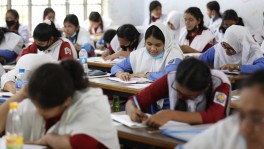Strong GDP growth, higher toll means Padma Bridge will pay for itself
In the next 35 years, the Bridges Division will pay around Tk36,403 crore including interest in quarterly instalments

Although it was earlier believed that toll payments would not be enough to recover the full construction cost of the Padma Bridge, the country's continuous economic growth means the money can be paid in full within 35 years.
When the primary feasibility study was conducted for the bridge in 2001, it estimated that only 88% of the construction cost would be recovered from toll payments, assuming the country's GDP rose to Tk7.35 lakh crore by 2024.
At the time, Bangladesh's gross domestic product (GDP) was Tk2.54 lakh crore, while the project cost was Tk10,162 crore.
Despite possible financial losses, the government started implementing the project to create an efficient road transportation system, save commute time, contribute to industrialisation and add value to various socio-economic indicators.
The construction cost of the bridge, however, more than doubled to Tk30,193 crore due to various complications. Fortunately, the country's GDP also marched forward, increasing by more than 15 times to reach Tk39.76 lakh crore.
The feasibility study also estimated that around 60% of the vehicles crossing Mawa and Jazira were non-motorised vehicles. However, since then the number of trucks and buses has increased by 11% each year, while non-motorised vehicles, like rickshaws and vans, have come down to nearly zero.
Besides, the toll rates have also been increased recently, exceeding the initial estimation.
Shamsul Haque, transport expert and professor at the Bangladesh University of Engineering and Technology (Buet), said feasibility studies can never accurately calculate the financial profits, as seen in the case of the Bangabandhu Bridge over the Jamuna River.
"The economy of the northern districts of the country got a big boost after the opening of the Bangabandhu Bridge. It was completely unimaginable. If the number of vehicles increases several times on the bridge more than a hundred kilometres away from the capital, why wouldn't the same happen in case of the Padma bridge?" he said.
Of the total construction cost of the Padma bridge – Tk30,193 crore – the government provided a grant of Tk300 crore and the remaining Tk29,893 crore was provided by the finance department of the government as a loan with one percent interest rate.
In the next 35 years, the Bridges Division will pay around Tk36,403 crore, including the interest, in quarterly instalments. As such, the debt would be fully paid by 2057.
To repay the loan, the bridges division will need Tk826 crore to Tk1,475 crore each year. However, the loan could be paid in advance if the Bridges Division wishes to do so.
Moreover, a loan of around Tk170 crore was taken from the Asian Development Bank in two phases for the design of the Padma bridge. This amount has to be paid in 20 years with a five-year grace period.
The first of this two-phase loan has to be repaid by 2028 and the second by 2029.
The finance division will foot the bill since the bridge is yet to generate any income.
According to the Bridges Division officials, at the beginning there would be a deficit in obtaining tolls, which would be met with the toll revenue generated by Bangabandhu Bridge and Muktarpur Bridge. If the number of vehicles increases, there will be some surplus after 20 years.
According to World Bank sources, there were regular surpluses after repaying the loan instalments in case of the Jamuna Bridge which was built on foreign loans and inaugurated in 1998. In 2010, the surplus amounted to Tk800 crore. However, subsequent major renovations and increased operating costs of the bridge led to some deficits.
The construction cost of the Bangabandhu Bridge was Tk3,746 crore. Till last year, Tk6,434 crore worth of tolls was collected from this bridge, according to the Bridges Division.
Although the target was to recover the investment in 25 years, the entire money, including construction and maintenance costs, were made back seven years before the stipulated time.




















